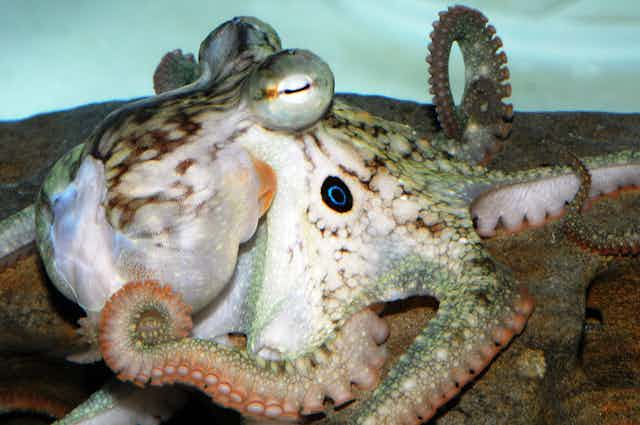Octopuses are among the most impressive of the invertebrates thanks to their ability to solve puzzles, camouflage perfectly with their surroundings, mimic other species, use tools and potentially predict world cup victories.
Now that scientists this month have published the first octopus genome we are a step closer to understanding how these feats are achieved in a lineage so divergent from our own.
The octopus genome was of the California two-spot (Octopus bimaculoides) and it may provide us with some leads on how the highly unusual octopod body plan evolved.
Interesting body plan
Octopods are contained within the group Cephalopoda, which literally means “head-footed”, as the foot (i.e. the octopus arms) are connected directly to the head.
One family of genes that is known to influence body plan in animals is called Hox. These genes usually occur together, clustered in groups, and the order of the genes directly corresponds to the order in which they are activated along the body during development.
In the octopus genome the scientists found the Hox genes are completely scattered, with no two of them occurring together. This scattered nature of the Hox genes across the genome may provide insights into octopod body plan development and why octopus have a much more unusual body plan than their cousins, such as snails and oysters.
Another big finding of this octopus genome project is actually something the authors did not find: whole genome duplication. That is, evidence that the entire genome was duplicated throughout history so that two copies of the genome were present.
It was previously believed that a whole genome duplication event in the octopus lineage may have driven the evolution of some of the remarkable characteristics present within octopus, such as complicated behaviours including the use of tools or vertebrate-like eyes.
The idea was that a whole genome duplication event frees up a set of genes, allowing these copies to take on new functions. But the lack of evidence for this suggests other mechanisms are at play.
Blended genome
One of these mechanisms appears to be the huge expansion in some gene families previously thought to be expanded only in vertebrates and not in other invertebrate lineages. One of these families is the protocadherins, which are cell adhesion molecules required to establish and maintain nervous system organisation.
The octopus genome boasts 168 protocadherin genes, which presumably play a crucial role in the highly modified octopus nervous system and complex brain. In contrast, these protocadherins are found in relatively small numbers (17 to 25) in organisms such as limpets and oysters, and are completely absent in several invertebrate model organisms including the fruit fly and nematodes.
The fact that protocadherin genes occur in large numbers in vertebrates and octopus but not in other animals, and that they are expressed in octopus neural and sensitive tissues (suckers and skin), suggests that they might play an important role in the evolution of cephalopod neural complexity.
Protocadherin diversity provides a mechanism to establish the synaptic connections needed to interpret the vast amount of stimuli, including touch and smell perceived through the suckers, and organise complex behavioural responses like camouflaging through the change in skin colour and texture/sculpture. It is interesting that the diversity in these genes has been generated by different mechanisms in octopus and vertebrates.
The genome also shows a lot of evidence for transposon activity. Transposons are DNA sequences that move locations around the genome (sometimes called “jumping genes”) and they can drive evolution.
In comparison to other genomes, the scientists note that the octopus genome looks like it has been “put into a blender and mixed”. They show that these transposons play an important role in driving this mixing of the genome.
They also found that transposons are highly expressed in neural tissues. They suggest that these may play an important role in memory and learning as shown in mammals and flies.
The ability of octopuses to learn and solve puzzles is something that is fascinating to us and so this will be a fruitful area for further research.
Why did it take so long?
It is more than 14 years since the human genome was published in Nature and Science, and numerous genomes have been published since then such as pandas, bees and recently 48 species of bird.
But this latest publication represents the first genome of any cephalopod and one of only a handful of molluscs, (the group containing cephalopods). Other molluscan genomes include the limpet (Lottia gigantea), oyster (Crassostrea gigas) and the sea hare (Aplysia californica).
This first octopus genome gives us great insight into the evolution and function of this fascinating group and will serve as a great catalyst for further research on cephalopod genetics.

